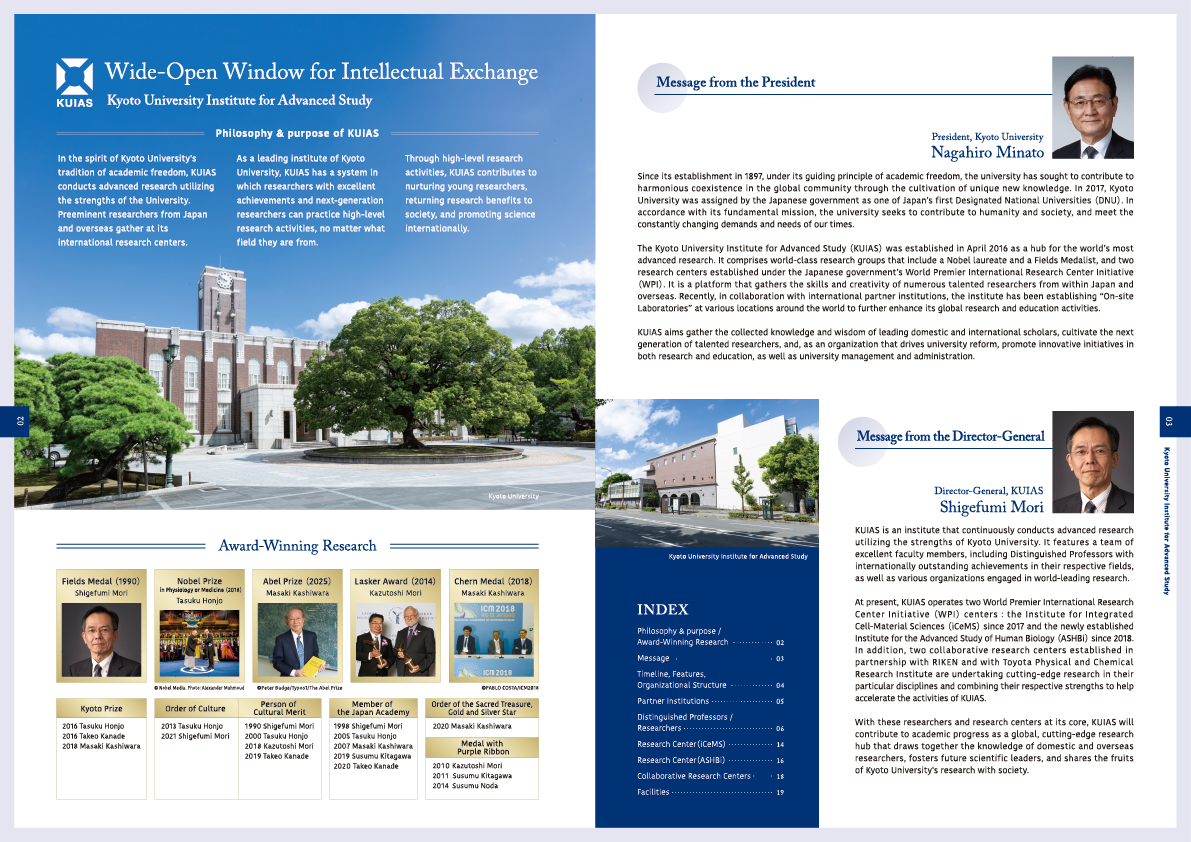Features and Organizational Structure of KUIAS
KUIAS has the following features as an institute to grow into a leading center based on a new paradigm:
Management with superb mobility under the strong leadership of the President
Application of a pioneering organization system designed for a "special zone" within the university
● System to allow world-leading excellent researchers to continue their research regardless of the conventional mandatory retirement age

Organizational Structure
KUIAS plays a leading role as a global research institute to perform advanced international research.

Center for Advanced Study
Researchers, including Distinguished Professors who are with globally recognized research outcomes, actively conduct their advanced research activities and contribute to human resource development, sharing of study results with society, and to the global evolution of science.
Research Center
Institute for Integrated Cell-Material Sciences(iCeMS)
iCeMS continues the concept of World Premier International Research Center Initiative (WPI), and aims to create new academic disciplines integrating materials science and cell biology.
Institute for the Advanced Study of Human Biology(ASHBi)
ASHBi implements the concept of World Premier International Research Center Initiative (WPI), and aims to create new academic disciplines uncovering the core principles of human beings and disease states.
Collaborative Research Centers
RIKEN-Kyoto University Advanced Research Platform
Through collaboration between Kyoto University and RlKEN, this Platform aims to conduct joint research by using their respective potencies, extending the borders of their research organizational frameworks and study areas.
It further strives to promote the world's most advanced research, leading to the development of new research horizons, and motivate next-generation researchers to advance its endeavors.
SUURI-COOL Kyoto
The first collaborative center with RIKEN was established within KUIAS in 2017. Its ultimate goal is to unravel the mysteries of the universe, matter and life, as well as address various key issues of modern society through its unique interdisciplinary approaches focusing on mathematics. We conduct researcher exchanges, joint research, and training of young researchers in various forms with the Graduate School of Science (human resource development in the mathematical sciences), the Graduate School of Advanced Integrated Studies in Human Survivability (social sciences), the Research Institute for Mathematical Sciences (mathematics) and Yukawa Institute for Theoretical Physics, Kyoto University (theoretical physics).
HIKARI-COOL Kyoto
HIKARI-COOL Kyoto was established in 2025 within the RIKEN-Kyoto University Advanced Research Platform, a collaborative initiative between RIKEN and Kyoto University. The primary objective is to address various challenges in fundamental physics and generate novel advancements in the field of photonic quantum science. This center is developing quantum electronic technologies, such as ultra-precise and quantum light sources. It is also pioneering advanced observation methods, including quantum sensing and high-sensitivity imaging. Furthermore, the center is exploring the optical properties of next-generation semiconductors, such as wide-bandgap semiconductors. Through these activities, HIKARI-COOL Kyoto aims to promote the development of next-generation research personnel.
Toyota Riken-Kyoto University Research Center (TRiKUC)
The Toyota Riken-Kyoto University Research Center (TRiKUC) performs collaborative research mainly on unconventional superconductors with the aim of contributing to the advancement of basic science, fostering the next generation of research professionals, circulating outstanding research talent both within Japan and overseas, and sharing its research outcomes with wider society.
Meaning of Logo

KUIAS has two major features as:
1. A place for distinguished researchers to gather for high-level research
2. A hub to connect all associated units in and outside Kyoto University
The motif of "window" has consequently be chosen to represent the above features.
We at KUIAS sincerely hope that, with this logo as its starting point, the institute will become a hub for all researchers working on the worldwide level.
* The logo was created through collaboration between Eiri Ono, a University Research Administrator (URA) of the Center for Enhancing Next Generation Research (E-NER) who made the original plan, and graphic designer Akio Okumura.


